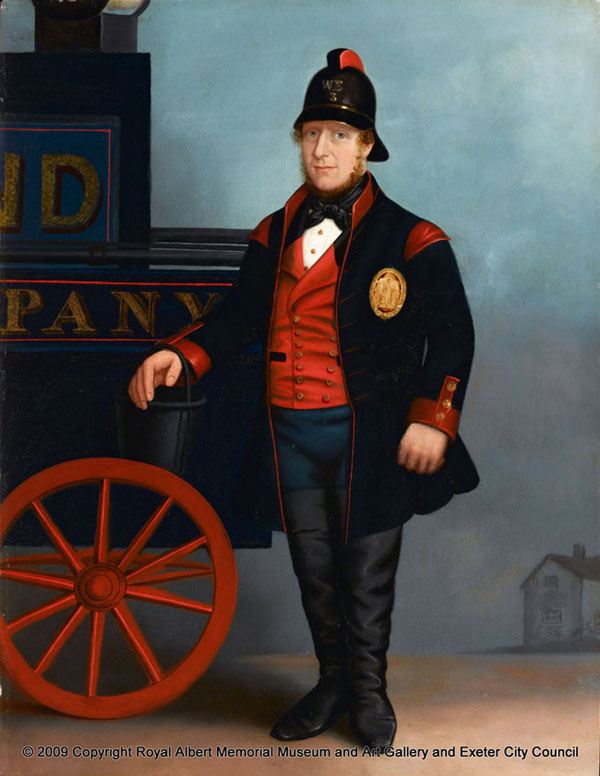Case Study 15: Thomas Camble by an anonymous artist of the English School, c.1860-80
This study investigates the identity of the sitter, and pays particular attention to the spelling of his name. It demonstrates how an investigation of the portrait donor, particularly when local and a near contemporary of the sitter, can yield information about the portrait.
“This portrait and the material associated with Charles Lewis, Secretary of the West of England Fire Insurance Company, came to the museum from the Norwich Union, now Aviva.
The identification of the sitter as Thomas Gamble rests on the wording of a plaque attached to the centre of the frame. It reads: ‘Mr Thomas Gamble West of England Fire Brigade, Exeter 1860-70 presented by Mr W C Loaring’. It appears that this plaque was applied when the portrait was given to the Norwich Union collection for their Exeter office.
Accordingly an extensive search under the name Gamble was made of a wide range of source material, including countrywide coverage of census returns from 1861-1901. The result was disappointing and further searches were made to trace any company records of the West of England Fire Insurance Company that might include lists of employees. No relevant material has so far come to light.
However, research into the family of the donor, Mr W.C.Loaring has produced some very significant leads. A new search of the census returns for England from 1861-1901 was run for the Loaring family. It revealed a family connection between the Loarings and a family called Camble.
It also demonstrated that the Cambles and Loarings were well represented in the Exeter and Silverton area of Devon. That the family was related is evident in the application of the Camble name as a forename to some of the Loarings e.g. Thomas Camble Loaring born in St.Thomas Exeter was working in London as an ironmonger’s assistant in the 1901 census.
At the same date there is a record of the Loaring family in Exeter, which is worth setting out in some detail. At 49 Summerland Street lived John and Ann Loaring with their family of three sons (Charles, Walter and Willie) and a boarder, the eighty-year old widow Ann Camble who was born in Aylesbeare. John Camble’s occupation was ‘Fire & Life Insurance Agent’. It seems very likely that the youngest son, Willie Loaring was the donor W. C. Loaring.
We know from other sources that Willie Camble Loaring (1893-1970) was a distinguished chemist. Is this the donor of the painting to the Norwich Union and perhaps the misreading of the family name followed when the plaque was produced?
If this theory is correct then we need to find a suitable Thomas Camble in the Exeter records. Again, the census combined with the IGI for parish registers help us locate the most likely candidate. This is Thomas Camble, son of William and Jane Camble, who was christened at St Mary Major, Exeter on 28 March 1824. In the 1851 census Thomas appears with his wife Ann (born at Aylesbeare) and a daughter of the same name living in the parish of St.Mary Arches. His occupation was given as smith. Thirty years later, living at 4 Mary Arches Street, his occupation has changed to ‘Waterman in the employ of the Exeter Corporation Waterwks’. It might be questioned whether this can be ‘our’ man because nowhere is his occupation given as fireman. However, it is clear that as elsewhere, the Fire Insurance Companies of the nineteenth century employed both regular and part-time firemen. The job of waterman with the Corporation would also seem to have useful links with the skills and knowledge Camble would have needed about the availability of water supplies in the city. Thomas Camble died towards the end of 1891 at the age of 69. His widow then went to live with John and Ann Loaring in Summerland Street.
The portrait is particularly useful in clearly depicting the uniform of the day. Thomas Camble wears a full-skirted frockcoat with buttoned cuffs over a double-breasted red waistcoat. Protecting his legs and feet are long leather boots, while the leather helmet with its distinctive red cresting has an enlarged tailpiece to protect the neck from falling materials. On the front of his jacket is an oval brass plate identifying the company. A generation earlier the plate would have been worn on the arm of the jacket, while leather helmets were gradually replaced by brass ones from the end of the 1860s (1). Camble’s left arm rests on a leather fire bucket, part of the equipment associated with the four wheeled manual pump shown in the painting.”
Author: Stephen Price
Footnotes
- Phillis Cunnington & Catherine Lucas Occupational Costume in England from the eleventh century to 1914 (London: Adam & Charles Black,1976) pp. 261-276 (Chapter XI Firemen).

